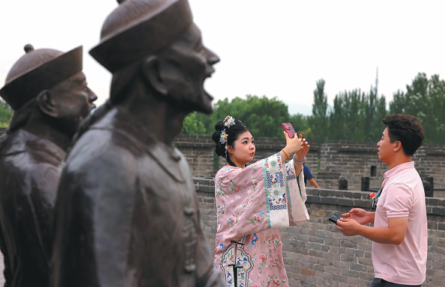Shanxi promotes rich traditional culture

Province is home to largest number of ancient buildings in China
In recent years, as the preservation and promotion of China's rich traditional culture have advanced steadily, public interest in ancient architecture has been increasing.
During this year's two sessions — the annual gatherings of the country's top legislature and political advisory body, which concluded last week in Beijing — many representatives from across the country discussed the deep integration of culture and tourism and offered suggestions to drive high-quality economic development through the preservation and promotion of historical treasures.
On March 6, at the open group meeting of the Shanxi delegation during the third session of the 14th National People's Congress, Tang Dengjie, an NPC deputy and Party secretary of Shanxi, shared a story.
"Last year, leveraging the popularity of the video game Black Myth: Wukong, we launched the 'Follow Wukong to Tour Shanxi' campaign, which significantly boosted our cultural tourism sector," he said.
"People say Shanxi has been blessed with a 'downpour of prosperity', and I believe we've received it well."
Tang said that the success of the campaign strengthened the government's resolve to transform cultural tourism into a pillar industry and a source of happiness for the people.
Shanxi, home to the largest number of ancient buildings in China, boasts 28,027 ancient structures. Among them are three wooden structures from the Tang Dynasty (618-907 AD), and the world's tallest wooden pagoda, the Yingxian Wooden Pagoda, which was built in 1056.
Of the 36 scenes in Black Myth: Wukong, 27 are in Shanxi, mainly featuring the province's grottoes, temples, ancient buildings, sculptures and murals. It represents only 5 percent of Shanxi's 531 nationally protected cultural relics, highlighting the province's rich cultural resources.
Discussing how Shanxi plans to develop new quality productive forces, Tang said that the province is fully leveraging its cultural tourism market advantages, vigorously expanding new "culture plus tourism" industries and products.
During this year's Spring Festival, Shanxi's innovative approach to tourism resulted in a total tourism expenditure of 31.7 billion yuan ($4.4 billion), a 30 percent increase from the same period of the previous year.
In Huangcheng village in Yangcheng county, rural tourism has become a new leading industry.
The village was the birthplace of Chen Tingjing, a prominent minister during the Qing Dynasty (1644-1911). He was not only a teacher of Emperor Kangxi but also the chief editor of the Kangxi Dictionary, a Chinese dictionary published in 1716 and considered from the time of its publishing until the early 20th century to be the most authoritative reference for written Chinese characters.
Today, Chen's residence, known as the House of the Huangcheng Chancellor, a well-protected architectural complex from the Ming (1368-1644) and Qing dynasties, is celebrated as "the first mansion of northern China". It attracts numerous domestic and international tourists with its unique charm and historical heritage.
Chen Xiaoshuan, an NPC deputy and head of Huangcheng village, said, "This Spring Festival, we introduced many intangible cultural heritage performances and village fairs to meet the diverse tourism consumption needs."
Last year, he said, the House of the Huangcheng Chancellor Group received 2 million visitors, generating over 100 million yuan in direct tourism revenue. The village has also embraced modern technology, using big data and artificial intelligence to enhance the tourist experience with smart guides and online booking.
The increasing interest among young people in historical sites has spurred a movement for the preservation of ancient buildings, said Hang Kan, an NPC deputy and director of Yungang Research Institute, which administers the Yungang Grottoes, a UNESCO World Cultural Heritage Site in Datong city. He said the grottoes have seen nearly 4.5 million visitors since 2024.
The Yungang Grottoes have been undergoing digital preservation since 2001, with two-thirds of the caves already digitally recorded.
Hang said that using augmented reality to bring the grottoes to life allows visitors to experience their grandeur virtually.
The popular activity of "high-fiving" the Giant Buddha statue from a distance has become a must-do for young visitors.
The Shanxi delegation proposed the creation of a Demonstration Zone for the Inheritance and Transformation of Chinese Excellent Culture, aiming to enhance the international influence of Shanxi's world heritage sites such as the Yungang Grottoes, Pingyao Ancient City and Mount Wutai.
The initiative seeks to establish Shanxi as a global cultural exchange center, making the province a showcase for the harmonious integration of China's excellent traditional culture and modern achievements.
Contact the writers at zhuxingxin@chinadaily.com.cn























